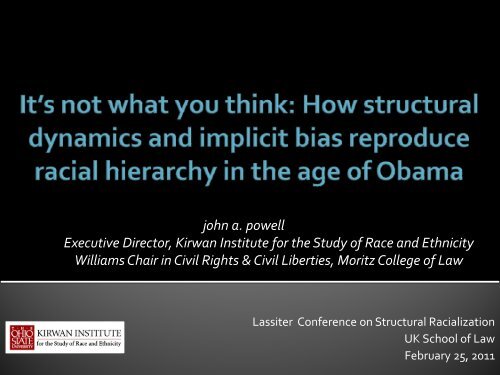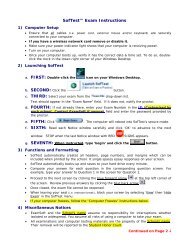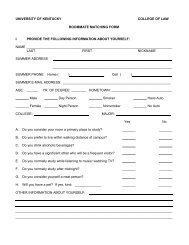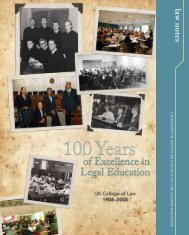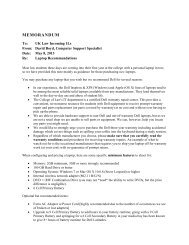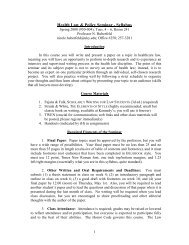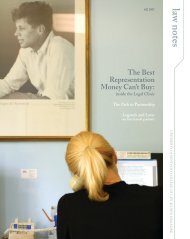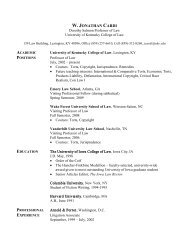PowerPoint Presentation - Renewing Beloved community ...
PowerPoint Presentation - Renewing Beloved community ...
PowerPoint Presentation - Renewing Beloved community ...
You also want an ePaper? Increase the reach of your titles
YUMPU automatically turns print PDFs into web optimized ePapers that Google loves.
john a. powell<br />
Executive Director, Kirwan Institute for the Study of Race and Ethnicity<br />
Williams Chair in Civil Rights & Civil Liberties, Moritz College of Law<br />
Lassiter Conference on Structural Racialization<br />
UK School of Law<br />
February 25, 2011
• Racial possibilities in the age of Obama<br />
• Structural Racialization<br />
• Arrangement of structures<br />
• Public/Private?<br />
• Corporate Prerogative and race<br />
• Mind Science<br />
• Challenging our biases<br />
2
• Why does race continue to play<br />
such a critical role in determining<br />
societal outcomes?<br />
• Haven’t we entered a post‐racial<br />
moment with the election of<br />
Barack Obama?<br />
• While significant, Obama’s<br />
victory does not erase the<br />
persistent inequalities that<br />
hinder the life chances for<br />
marginalized groups 3
• Black and Latino children are much more likely than<br />
white children to attend high‐poverty schools<br />
• A white man with a criminal record is three times<br />
more likely than a black man with a record to receive<br />
consideration for a job<br />
• Minority home‐seekers with good credit scores<br />
steered to high‐cost, sub‐prime mortgages thus<br />
devastating their communities in light of the<br />
foreclosure crisis<br />
By prematurely proclaiming a post-racial status, we<br />
ignore the distance we have yet to travel to make this<br />
country truly a land of equal opportunity for all,<br />
regardless of racial identity.<br />
4
• President Obama’s election “suggests that a sea change in<br />
race relations has already occurred”<br />
• However, his “exceptional racial background” and the fact he<br />
was elected in the midst of national crises indicates “race<br />
hasn’t been overcome so much as temporarily superseded.”<br />
• These crises could worsen racial resentment<br />
• “race forms a basis for the exploitation and hoarding of<br />
material, political, and cultural resources; in turn, the same<br />
processes that facilitate racial stratification continually<br />
reconstitute race.”<br />
Source: Lopez, Ian Haney. Post‐Racial Racism: Crime Control and Racial Stratification in the Age of Obama<br />
5
• We have fluidity in terms of racial identities<br />
▪ Situations affect who you are, how you identify.<br />
▪ For example, it may not be until you’re in a room<br />
with full of people of a different race that you<br />
become truly aware of your own race.<br />
▪ The British did not become “white” until Africans<br />
became “black.”<br />
• In order to notice race, society has to create this<br />
category/idea of race. After it is created, individuals can<br />
negotiate it using the social tools created by society.<br />
6
• Although racial attitudes are improving, racial<br />
disparities persist on every level.<br />
• Inequity arises as disenfranchised groups are left<br />
out of the democratic process.<br />
Source: www.cartoonstock.com<br />
7
Membership, the most important<br />
good that we distribute to one<br />
another in human <strong>community</strong><br />
(Michael Walzer)<br />
◦ Prior in importance even to freedom<br />
◦ Citizenship, a precondition to<br />
freedom<br />
◦ Membership, a precondition to<br />
citizenship<br />
Distribution of membership<br />
Cost to not belong<br />
8
• The cost of membership in a democratic society<br />
• Current estimate for family of four: $48,778*<br />
▪ Over three times as many families fall below family<br />
budget thresholds as fall below the official poverty line<br />
• How far do you fall (children in extreme poverty,<br />
skyrocketing bankruptcy rates, family homelessness)?<br />
• Are all neighborhoods are neighborhoods of<br />
sustainable opportunity?<br />
Source: James Lin and Jared Bernstein, What we need to get by. October 29, 2008 |<br />
EPI Briefing Paper #224<br />
9
Categorization<br />
Conscious and<br />
Unconscious (i.e.<br />
implicit bias)<br />
Pattern<br />
recognition and<br />
generalization<br />
Hoarding and<br />
Exploitation<br />
Inequalit<br />
y<br />
Emulation<br />
and<br />
Adaptation<br />
This may<br />
change over<br />
time, but the<br />
whole<br />
structure is<br />
highly inert<br />
ource: Douglas Massey. Categorically Unequal: The American Stratification System. New York: Russell Sage Foundation. 2007.<br />
10
Implicit<br />
Bias<br />
Structural<br />
Racialization<br />
11
• How race works today<br />
• There are still practices, cultural norms and<br />
institutional arrangements that help create and<br />
maintain (disparate) racialized outcomes<br />
• Structural racialization addresses interinstitutional<br />
arrangements and interactions<br />
• It refers to the ways in which the joint operation<br />
of institutions produce racialized outcomes<br />
▪ In this analysis, outcomes matter more than intent<br />
12
Context: The Dominant Consensus on Race<br />
National values<br />
Contemporary culture<br />
Current Manifestations: Social and Institutional Dynamics<br />
Processes that maintain racial<br />
hierarchies<br />
Racialized public policies and<br />
institutional practices<br />
Racial inequalities in current levels of<br />
well‐being<br />
Outcomes: Racial Disparities<br />
Capacity for individual and <strong>community</strong><br />
improvement is undermined<br />
Ongoing Racial Inequalities<br />
Adapted from the Aspen Roundtable on Community Change. “Structural Racism and Community Building.” June 2004<br />
13
• One variable can explain<br />
why differential outcomes.<br />
…to a multi‐dimensional understanding….<br />
• Structural Inequality<br />
– Example: a Bird in a cage.<br />
Examining one bar cannot<br />
explain why a bird cannot fly.<br />
But multiple bars, arranged<br />
in specific ways, reinforce<br />
each other and trap the bird.<br />
14
• Understanding the<br />
relationships among<br />
these multiple<br />
dimensions, and how<br />
these complex intraactions<br />
change<br />
processes<br />
• Relationships are<br />
neither static nor<br />
discrete<br />
15
Physical<br />
Social<br />
Cultural<br />
Outcomes<br />
These structures interact in ways that produce racialized outcomes for<br />
different groups…<br />
16
Racialized…<br />
•In 1960, African‐<br />
American families in<br />
poverty were 3.8 times<br />
more likely to be<br />
concentrated in highpoverty<br />
neighborhoods<br />
than poor whites.<br />
•In 2000, they were 7.3<br />
times more likely.<br />
Spatialized…<br />
• marginalized people<br />
of color and the very<br />
poor have been<br />
spatially isolated<br />
from opportunity via<br />
reservations, Jim<br />
Crow, Appalachian<br />
mountains, ghettos,<br />
barrios, and the<br />
culture of<br />
incarceration.<br />
Globalized…<br />
• Economic<br />
globalization<br />
• Climate change<br />
•the Credit and<br />
Foreclosure crisis<br />
17
LOW OPPORTUNITY<br />
• Less than 25% of students in<br />
Detroit finish high school<br />
• More than 60% of the men<br />
will spend time in jail<br />
• There may soon be no bus<br />
service in some areas<br />
• It is difficult to attract jobs or<br />
private capital<br />
• Not safe; very few parks<br />
• Difficult to get fresh food<br />
HIGH OPPORTUNITY<br />
• The year my step daughter<br />
finished high school, 100% of<br />
the students graduated and<br />
100% went to college<br />
• Most will not even drive by a<br />
jail<br />
• Free bus service<br />
• Relatively easy to attract<br />
capital<br />
• Very safe; great parks<br />
• Easy to get fresh food<br />
18
Which <strong>community</strong> would you choose?<br />
19
How can we be sensitive to<br />
inter‐ and intra‐group<br />
differences?<br />
How do the ladders or<br />
pathways of opportunities<br />
differ for different people?<br />
Every institution has built in<br />
assumptions, i.e. “stairways”<br />
are a pathway – but not for<br />
people in wheelchairs, baby<br />
strollers.<br />
20
…Some people ride the<br />
“Up” escalator to reach<br />
opportunity<br />
…Others have to run up<br />
the “Down” escalator to<br />
get there<br />
21
People are “differentially situated”<br />
Not only are<br />
people situated<br />
differently with<br />
regard to<br />
institutions,<br />
people are<br />
situated<br />
differently with<br />
regard to<br />
infrastructure<br />
People are<br />
impacted by the<br />
relationships<br />
between<br />
institutions and<br />
systems…<br />
…but people<br />
also impact<br />
these<br />
relationships<br />
and can change<br />
the structure of<br />
the system.<br />
22
• We come from different places. Illuminating people’s<br />
different and shared experiences of oppression<br />
encourages collective action with others whose<br />
experiences may be slightly different.<br />
• Young’s 5 Faces of Oppression: Different<br />
groups/people experience one or more of these<br />
faces throughout their lives<br />
• Exploitation<br />
• Marginalization<br />
• Powerlessness<br />
• Cultural Dominance<br />
• Violence<br />
Source: Grassroots Policy Project. “Faces of Oppression.” http://www.grassrootspolicy.org/node/85<br />
23
Segregation impacts a number of life‐opportunities<br />
Impacts on Health<br />
School Segregation<br />
Impacts on Educational Achievement<br />
Neighborhood<br />
Segregation<br />
Exposure to crime; arrest<br />
Transportation limitations and other<br />
inequitable public services<br />
Job segregation<br />
Racial stigma, other psychological<br />
impacts<br />
Source: Barbara Reskin (http://faculty.washington.edu/reskin/)<br />
Impacts on <strong>community</strong> power and<br />
individual assets<br />
24
• Zoning laws prevent affordable housing<br />
development in many suburbs<br />
• Municipalities subsidize the relocation of<br />
businesses out of the city<br />
• Transportation spending favors highways,<br />
metropolitan expansion and urban sprawl<br />
• Court decisions prevent metropolitan school<br />
desegregation<br />
• School funding is tied to property taxes<br />
25
• How we arrange structures matters<br />
• The order of the structures<br />
• The timing of the interaction between them<br />
• The relationships that exist between them<br />
• We must be aware of how structures are arranged<br />
in order to fully understand social phenomena<br />
26
• One cannot have a just society unless the<br />
arrangement of institutions are just.<br />
• John Rawls<br />
27
• The government plays a central role in the<br />
arrangement of space and opportunities<br />
• These arrangements are not “neutral” or<br />
“natural” or “colorblind”<br />
• Social and racial inequities are geographically<br />
inscribed<br />
• There is a polarization between the rich and<br />
the poor that is directly related to the areas in<br />
which they live<br />
28
• Racialized policies and structures:<br />
• Promoted sprawl<br />
• Concentrated subsidized housing<br />
• Led to disparities between schools<br />
▪ Achievement gap<br />
▪ Discipline rates<br />
▪ Funding disparities<br />
▪ Economic segregation<br />
▪ Graduation rates<br />
▪ Racial segregation<br />
29
Photo source: (Madoff) AP<br />
30
Today…<br />
Institutions and structures<br />
continue to support, not<br />
dismantle, the status quo.<br />
This is why we continue to<br />
see racially inequitable<br />
outcomes even if there is<br />
good intent behind policies,<br />
or an absence of racist<br />
actors. (i.e. structural<br />
racialization)<br />
31
• A series of mutually reinforcing federal<br />
policies across multiple domains have<br />
contributed to the disparities we see today<br />
• School Desegregation<br />
• Homeownership/Suburbanization<br />
• Urban Renewal<br />
• Public Housing<br />
• Transportation<br />
32
• Distinction blurred<br />
Examples:<br />
• Private colleges<br />
• Housing as a private good<br />
complemented by<br />
government policies<br />
• GI Bill<br />
• Expansion of highway system<br />
• Fannie Mae and Freddie Mac<br />
33
• Civil Rights Act of 1875 –equal treatment in<br />
“public accommodations”<br />
• Citizenship clause and membership in political<br />
<strong>community</strong><br />
• Overturned by Supreme Court eight years later<br />
• “The wrongful act of an individual, unsupported by<br />
any such authority, is simply a private wrong, or a<br />
crime of that individual”<br />
34
• Private vs. public<br />
discrimination<br />
• Tension between addressing<br />
state action vs. de facto<br />
conditions produced by<br />
“private” decisions<br />
Source: CSUN Daily Sundial Newspaper<br />
35
“What the nation, through Congress,<br />
has sought to accomplish in reference<br />
to that race is, what had already been<br />
done in every state in the Union for the<br />
white race, to secure and protect rights<br />
belonging to them as freemen and<br />
citizens; nothing more. The one<br />
underlying purpose of congressional<br />
legislation has been to enable the black<br />
race to take the rank of mere citizens.”<br />
36
"The distinction between government<br />
and private action, furthermore, can<br />
be amorphous both as a historical<br />
matter and as a matter of present‐day<br />
finding of fact. Laws arise from a<br />
culture and vice versa. Neither can<br />
assign to the other all responsibility for<br />
persisting injustices.”<br />
37
• Misidentifying the<br />
situation, not<br />
public vs. private<br />
• Expansion of<br />
corporate<br />
prerogative<br />
Public Private<br />
Private<br />
Domains<br />
Corporate<br />
• Corporate space<br />
diminishes public<br />
& private space<br />
Non‐pubic<br />
Corporate<br />
38
• Corporations under control of state for much of US<br />
history –serving a public function<br />
• Natural entity theory:<br />
corporations as<br />
separate juridical<br />
entities with separate<br />
rights<br />
• Fourteenth<br />
amendment and<br />
corporate<br />
personhood<br />
Source: Terrence Nowicki Jr. ThisIsHistoricTimes.com<br />
39
• Taney Court: states’ rights, anti‐elitism and<br />
denial of citizenship to blacks<br />
• “provided a coherent defense of both corporations<br />
and slavery in a rapidly democratizing union”<br />
(Austin Allen)<br />
• Corporate dominance connected to whiteness<br />
• “middle‐stratum identity” (Martinot)<br />
• Citizens United: expansion of corporate rights<br />
and reduction of civil rights<br />
Source: powell, j. and C. Watt.“Corporate Prerogative, Race, and Identity Under the Fourteenth<br />
Amendment.” Cardoza Law Review Vol. 32:3.<br />
40
• Capitalist Welfare State<br />
• Property Owning Democracy<br />
• John Rawls: Justice as Fairness<br />
41
CORNEL WEST: “…I don’t think President<br />
Bush individually hates black people. His<br />
policies were racist in effect and consequence,<br />
and especially classist in terms of generating<br />
misery among poor and working people,<br />
disproportionately black and brown…And I<br />
would say that even about the Obama<br />
administration.” (Democracy Now!)<br />
42
• The twentieth century has been<br />
characterized by three developments of<br />
political importance;<br />
• 1)the growth of democracy;<br />
• 2)the growth of corporate power; and<br />
• 3)the growth of propaganda as a means of<br />
protecting corporate power against<br />
democracy. Alex Carey<br />
43
http://www.youtube.com/watch?v=A5_7Ap0gWMQ<br />
44
• Treasury report February 2011: “Reforming<br />
America’s Housing Finance Market”<br />
• Does not mention role of segregation in housing and<br />
credit markets in subprime crisis<br />
• Three options laid out: variations of privatization<br />
• Potentially<br />
mortgage costs, down payments,<br />
fees/costs for FHA loans<br />
• Disproportionate impact on people of color and lowincome<br />
communities<br />
45
Universal<br />
Programs<br />
Targeted<br />
Programs<br />
Targeted<br />
Universalism<br />
46
• Targeted Universalism recognizes racial<br />
disparities and the importance of eradicating<br />
them, while acknowledging their presence<br />
within a larger inequitable, institutional<br />
framework<br />
• Targeted universalism is a common framework<br />
through which to pursue justice.<br />
• A model which recognizes our linked fate<br />
• A model where we all grow together<br />
• A model where we embrace collective<br />
solutions<br />
47
Only 2% of emotional<br />
cognition is available to us<br />
consciously<br />
Racial bias tends to reside in<br />
the unconscious network<br />
Messages can be framed to<br />
speak to our unconscious<br />
51
• Racial attitudes operate in our “unconscious” (also<br />
called “subconscious”) mind<br />
• Usually invisible to us but significantly influences<br />
our positions on critical issues<br />
• Negative unconscious attitudes about race are<br />
called “implicit bias” or “symbolic racism.”<br />
52
How<br />
messages are<br />
framed<br />
affects how<br />
they are<br />
perceived.<br />
53
When scientists showed a similar sketch to people from East Africa ‐ a culture<br />
containing few angular visual cues ‐ the family is seen sitting under a tree. The<br />
woman is balancing an item on her head.<br />
Westerners are accustomed to the corners and box‐like shapes of architecture. They<br />
are more likely to place the family indoors and to interpret the rectangle above the<br />
woman's head as a window through which shrubbery can be seen.<br />
56
• Race is a social reality.<br />
• While we are hardwired to categorize ingroup<br />
vs. out‐group, we are “softwired” for<br />
the content of those categories.<br />
• Softwiring is social.<br />
• Racial categories and meaning<br />
can be constantly be reconfigured.<br />
57
High<br />
Pitied<br />
Out‐Group<br />
Esteemed<br />
In‐Group<br />
Warmth<br />
Low<br />
Despised<br />
Out‐Group<br />
Envied<br />
Out‐Group<br />
Low<br />
Competence<br />
High<br />
Source: Douglas Massey. Categorically Unequal: The American Stratification System. New York: Russell Sage Foundation. 2007.<br />
58
High<br />
Warmth<br />
Pity :<br />
women,<br />
elderly,<br />
disabled<br />
Esteemed:<br />
Your own group,<br />
who you identify<br />
with<br />
Low<br />
Despised:<br />
African<br />
Americans,<br />
Undocumented<br />
immigrants<br />
Envied:<br />
Competent, but<br />
don’t really like<br />
them: Asians<br />
Low<br />
Competence<br />
High<br />
Source: Douglas Massey. Categorically Unequal: The American Stratification System. New York: Russell Sage Foundation. 2007.<br />
59
• Unconscious biases are reflected in institutional<br />
arrangements.<br />
• Prejudice leads to outcomes, and the outcomes<br />
reinforce the stereotypes / prejudice.<br />
• Ex: Females aren’t good at math.<br />
Many females don’t take math classes.<br />
60
http://www.youtube.com/watch?v=yrqrkihlw‐s<br />
61
• Our environment affects our unconscious<br />
networks<br />
• Priming activates mental associations<br />
• Telling someone a scary story activates a frame of fear<br />
• Claude Steele’s “stereotype threat”:<br />
• For example, tell students about to take a test that<br />
Asian students tend to do better than whites, and the<br />
whites will perform significantly worse than if they had<br />
not been primed to think of themselves as less capable<br />
than Asians.<br />
Source: http://www.eaop.ucla.edu/0405/Ed185%20‐Spring05/Week_6_May9_2005.pdf<br />
62
• Experiment with 7 th graders; ~50% white & 50% Black<br />
• Given a list of values<br />
▪ Experimental group: Choose the values that are most important to<br />
you and write why they are important<br />
▪ Control group: Choose the values that are the least important to<br />
you and explain why<br />
• End of semester – While Black students still did not do as<br />
well as whites, the Black students in the experimental<br />
group showed a 40% reduction in the racial achievement<br />
gap.<br />
• Experiment was repeated with a group of college<br />
students and yielded a 50% reduction in the racial<br />
achievement gap.<br />
Source: Cohen, Geoffrey L.., Julio Garcia, Nancy Apfel, and Allison Master. (2006). “Reducing the Racial Achievement Gap: A<br />
Social‐Psychological Intervention.” Science 313(5791): 1307‐1310,<br />
63
• Be aware of implicit bias in your life. We are<br />
constantly being primed.<br />
• Debias by presenting positive alternatives.<br />
• Consider your conscious messaging & language.<br />
• Affirmative action support varies based on whether it’s<br />
presented as “assistance” or “preference.”<br />
• Engage in proactive affirmative efforts –not only<br />
on the cultural level but also the structural level.<br />
64
www.KirwanInstitute.org<br />
www.race-talk.org<br />
KirwanInstitute<br />
on:


